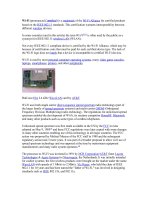Phân biệt mạng trong Internet
Bạn đang xem bản rút gọn của tài liệu. Xem và tải ngay bản đầy đủ của tài liệu tại đây (318.78 KB, 12 trang )
Wi-Fi (pronounced / waˈ ɪ fa ɪ / ) is a trademark of the Wi-Fi Alliance for certified products
based on the IEEE 802.11 standards. This certification warrants interoperability between
different wireless devices.
In some countries (and in this article) the term Wi-Fi
[1][2]
is often used by the public as a
synonym for IEEE 802.11-wireless LAN (WLAN).
Not every IEEE 802.11 compliant device is certified by the Wi-Fi Alliance, which may be
because of certification costs that must be paid for each certified device type. The lack of
the Wi-Fi logo does not imply that a device is incompatible to certified Wi-Fi-devices.
Wi-Fi is used by most personal computer operating systems, many video game consoles,
laptops, smartphones, printers, and other peripherals.
Half-size ISA 2.4 GHz WaveLAN card by AT&T
Wi-Fi uses both single carrier direct-sequence spread spectrum radio technology (part of
the larger family of spread spectrum systems) and multi-carrier OFDM (Orthogonal
Frequency Division Multiplexing) radio technology. The regulations for unlicensed spread
spectrum enabled the development of Wi-Fi, its onetime competitor HomeRF, Bluetooth,
and many other products such as some types of cordless telephones.
Unlicensed spread spectrum was first made available in the US by the FCC in rules
adopted on May 9, 1985
[3]
and these FCC regulations were later copied with some changes
in many other countries enabling use of this technology in all major countries. The FCC
action was proposed by Michael Marcus of the FCC staff in 1980 and the subsequent
regulatory action took 5 more years. It was part of a broader proposal to allow civil use of
spread spectrum technology and was opposed at the time by mainstream equipment
manufacturers and many radio system operators.
[4]
The precursor to Wi-Fi was invented in 1991 by NCR Corporation/AT&T (later Lucent
Technologies & Agere Systems) in Nieuwegein, the Netherlands. It was initially intended
for cashier systems; the first wireless products were brought on the market under the name
WaveLAN with speeds of 1 Mbit/s to 2 Mbit/s. Vic Hayes, who held the chair of IEEE
802.11 for 10 years and has been named the "father of Wi-Fi," was involved in designing
standards such as IEEE 802.11b, and 802.11a.
The original patents behind 802.11 Wi-Fi technology, filed in 1996, are held by the
CSIRO, an Australian research body. The patents have been the subject of protracted and
ongoing legal battles between the CSIRO and major IT corporations over the non-payment
of royalties. In 2009 the CSIRO reached a settlement with 14 companies, including
Hewlett-Packard, Intel, Dell, Toshiba, ASUS, Microsoft and Nintendo, on the condition
that the CSIRO did not broadcast the resolution.
[5][6][7][8]
[edit] Wi-Fi Alliance
Main article: Wi-Fi Alliance
The Wi-Fi Alliance promotes standards in order to improve the interoperability of wireless
local area network products based on the IEEE 802.11 standards. It is a consortium of
separate and independent companies, and agrees on a set of common interoperable
products based on the family of IEEE 802.11 standards.
[9]
The Wi-Fi Alliance certifies
products with a set of defined test procedures. The manufacturers with membership of Wi-
Fi Alliance and whose products pass these tests can mark their products and packaging
with the Wi-Fi logo.
[10]
[edit] Naming
The term Wi-Fi suggests Wireless Fidelity, compared with the long-established audio
recording term High Fidelity or Hi-Fi. Wireless Fidelity has often been used in an informal
way, even by the Wi-Fi Alliance itself, but officially the term Wi-Fi does not mean
anything.
The term Wi-Fi, first used commercially in August 1999,
[11]
was coined by a brand
consulting firm called Interbrand Corporation that had been hired by the Alliance to
determine a name that was "a little catchier than 'IEEE 802.11b Direct Sequence'."
[12][13][14]
Interbrand invented Wi-Fi as a play on words with Hi-Fi, and also created the yin yang-
style Wi-Fi logo.
The Wi-Fi Alliance initially complicated matters by stating that it "actually stood for"
Wireless Fidelity, as with the advertising slogan, "The Standard for Wireless Fidelity,"
[13]
but later removed the phrase from their marketing. The Wi-Fi Alliance's early White papers
still held on their website say: "…a promising market for wireless fidelity (Wi-Fi) network
equipment."
[15]
and "A Short History of WLANs." The yin yang logo indicates that a
product had been certified for interoperability.
[16]
The Alliance has since downplayed the connection to Hi-Fi. Their official position now is
that it is merely a brand name that stands for nothing in particular, and they now discourage
the use of the term Wireless Fidelity.
[citation needed]
[edit] Uses
A roof mounted Wi-Fi antenna
A Wi-Fi antenna
A Wi-Fi enabled device such as a PC, video game console, mobile phone, MP3 player or
PDA can connect to the Internet when within range of a wireless network connected to the
Internet. The coverage of one or more interconnected access points — called a hotspot —
can comprise an area as small as a single room with wireless-opaque walls or as large as
many square miles covered by overlapping access points. Wi-Fi technology has served to
set up mesh networks, for example, in London.
[17]
Both architectures can operate in
community networks.
In addition to restricted use in homes and offices, Wi-Fi can make access publicly available
at Wi-Fi hotspots provided either free of charge or to subscribers to various providers.
Organizations and businesses such as airports, hotels and restaurants often provide free
hotspots to attract or assist clients. Enthusiasts or authorities who wish to provide services
or even to promote business in a given area sometimes provide free Wi-Fi access. There are
already more than 300 metropolitan-wide Wi-Fi (Muni-Fi) projects in progress.
[18]
There
were 879 Wi-Fi based Wireless Internet service providers in the Czech Republic as of May
2008.
[19][20]
Wi-Fi also allows connectivity in peer-to-peer (wireless ad hoc network) mode, which
enables devices to connect directly with each other. This connectivity mode can prove
useful in consumer electronics and gaming applications.
When wireless networking technology first entered the market many problems ensued for
consumers who could not rely on products from different vendors working together. The
Wi-Fi Alliance began as a community to solve this issue — aiming to address the needs of
the end-user and to allow the technology to mature. The Alliance created the branding Wi-
Fi CERTIFIED to reassure consumers that products will interoperate with other products
displaying the same branding.
Many consumer devices use Wi-Fi. Amongst others, personal computers can network to
each other and connect to the Internet, mobile computers can connect to the Internet from
any Wi-Fi hotspot, and digital cameras can transfer images wirelessly.
Routers which incorporate a DSL-modem or a cable-modem and a Wi-Fi access point,
often set up in homes and other premises, provide Internet-access and internetworking to
all devices connected (wirelessly or by cable) to them. One can also connect Wi-Fi devices
in ad hoc mode for client-to-client connections without a router. Wi-Fi also enables places
which would traditionally not have network to be connected, for example bathrooms,
kitchens and garden sheds.
As of 2007 Wi-Fi technology had spread widely within business and industrial sites. In
business environments, just like other environments, increasing the number of Wi-Fi
access-points provides redundancy, support for fast roaming and increased overall
network-capacity by using more channels or by defining smaller cells. Wi-Fi enables
wireless voice-applications (VoWLAN or WVOIP). Over the years, Wi-Fi
implementations have moved toward "thin" access-points, with more of the network
intelligence housed in a centralized network appliance, relegating individual access-points
to the role of mere "dumb" radios. Outdoor applications may utilize true mesh topologies.
As of 2007 Wi-Fi installations can provide a secure computer networking gateway,
firewall, DHCP server, intrusion detection system, and other functions.
[edit] Airport Wi-Fi
In September of 2003, Pittsburgh International Airport became the first airport to offer free
Wi-Fi throughout its terminal.
[21]
[edit] City wide Wi-Fi
Further information: Municipal wireless network
Wikibooks has a book on the topic of
Nets, Webs and the Information Infrastructure
A municipal wireless antenna in Minneapolis
In the early 2000s, many cities around the world announced plans for a city wide Wi-Fi
network. This proved to be much more difficult than their promoters initially envisioned
with the result that most of these projects were either canceled or placed on indefinite hold.
A few were successful, for example in 2005, Sunnyvale, California became the first city in
the United States to offer city wide free Wi-Fi.
[22]
Few of the Municipal Wi-Fi firms have
now entered into the field of Smart grid networks.
[23][clarification needed]
[edit] Campus wide Wi-Fi
The first wi-fi network in the world was actually a campus based network. Pittsburgh's
Carnegie Mellon University went live with the first-ever wi-fi network in 1994.
[24]
[edit] Advantages and challenges
A keychain size Wi-Fi detector.
[edit] Operational advantages
Wi-Fi allows local area networks (LANs) to be deployed without wires for client devices,
typically reducing the costs of network deployment and expansion. Spaces where cables
cannot be run, such as outdoor areas and historical buildings, can host wireless LANs.
Wireless network adapters are now built into most laptops. The price of chipsets for Wi-Fi
continues to drop, making it an economical networking option included in even more
devices. Wi-Fi has become widespread in corporate infrastructures.









